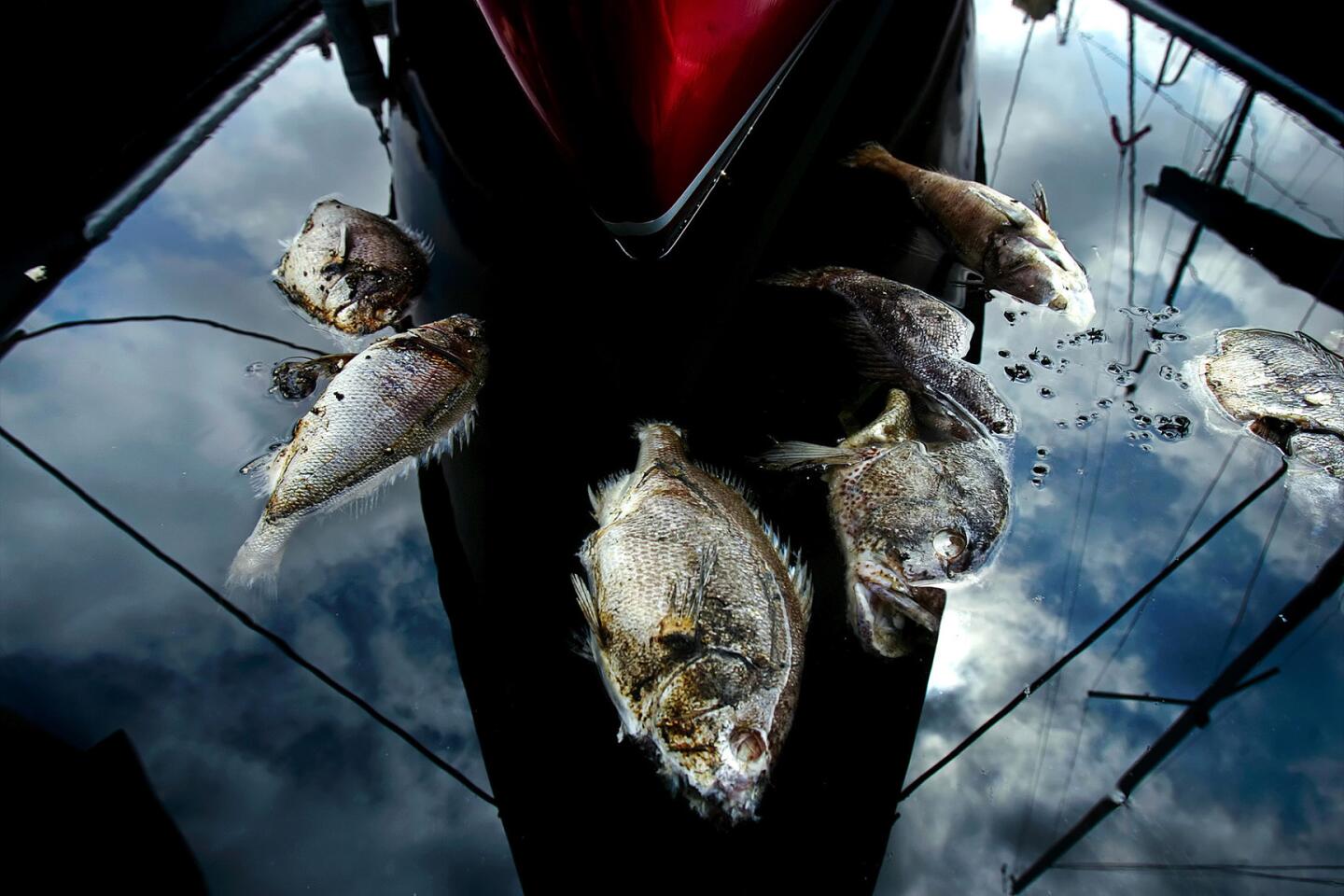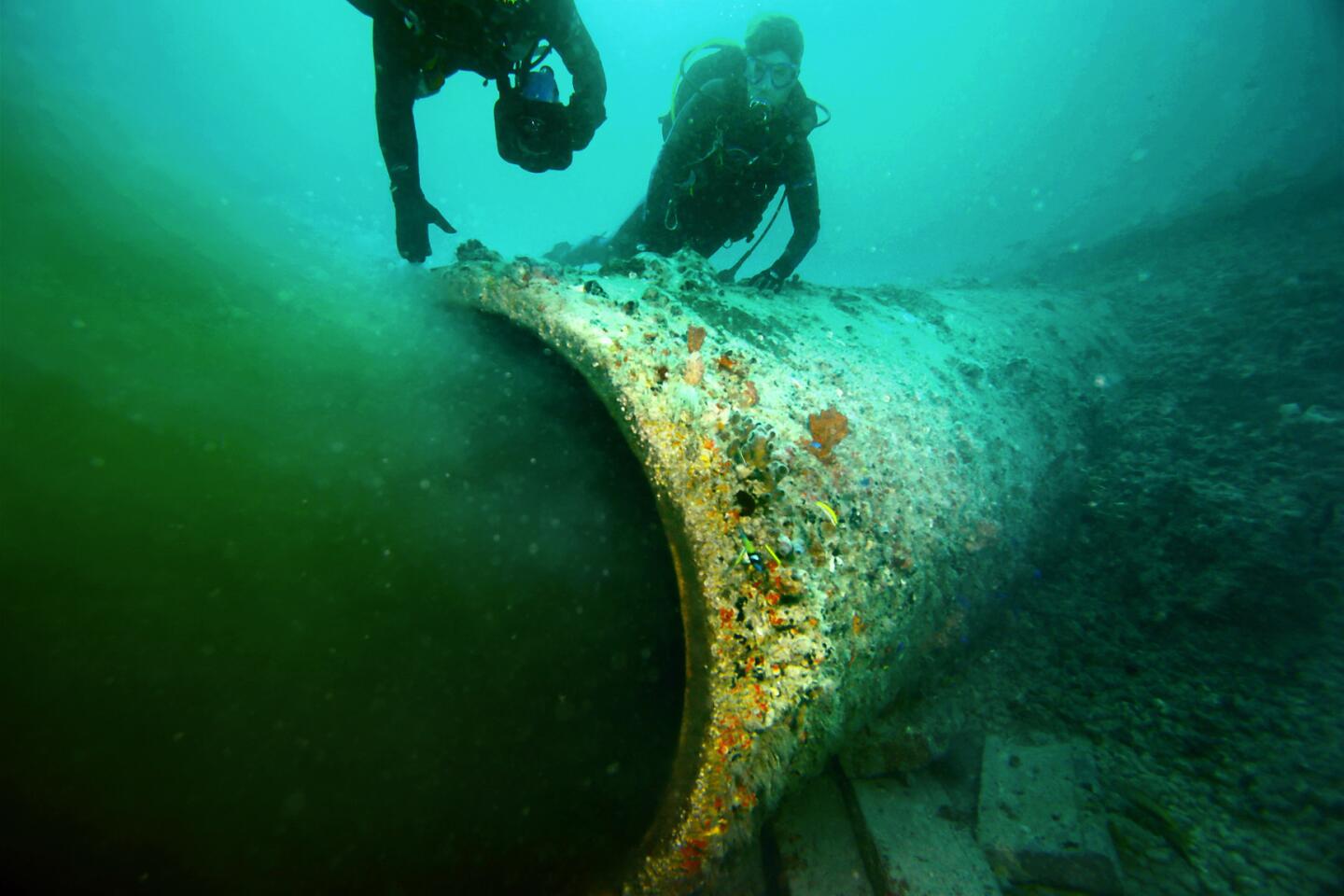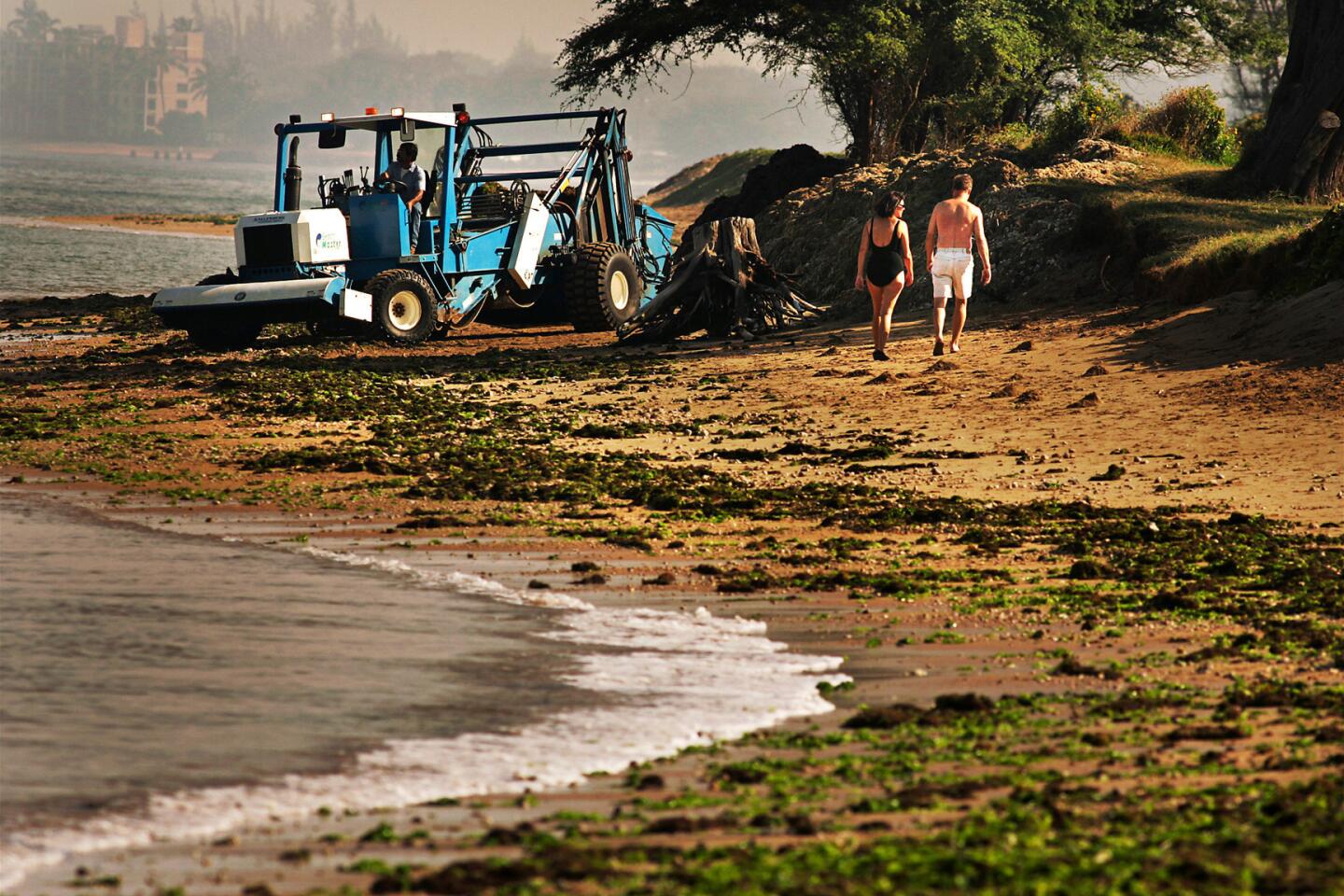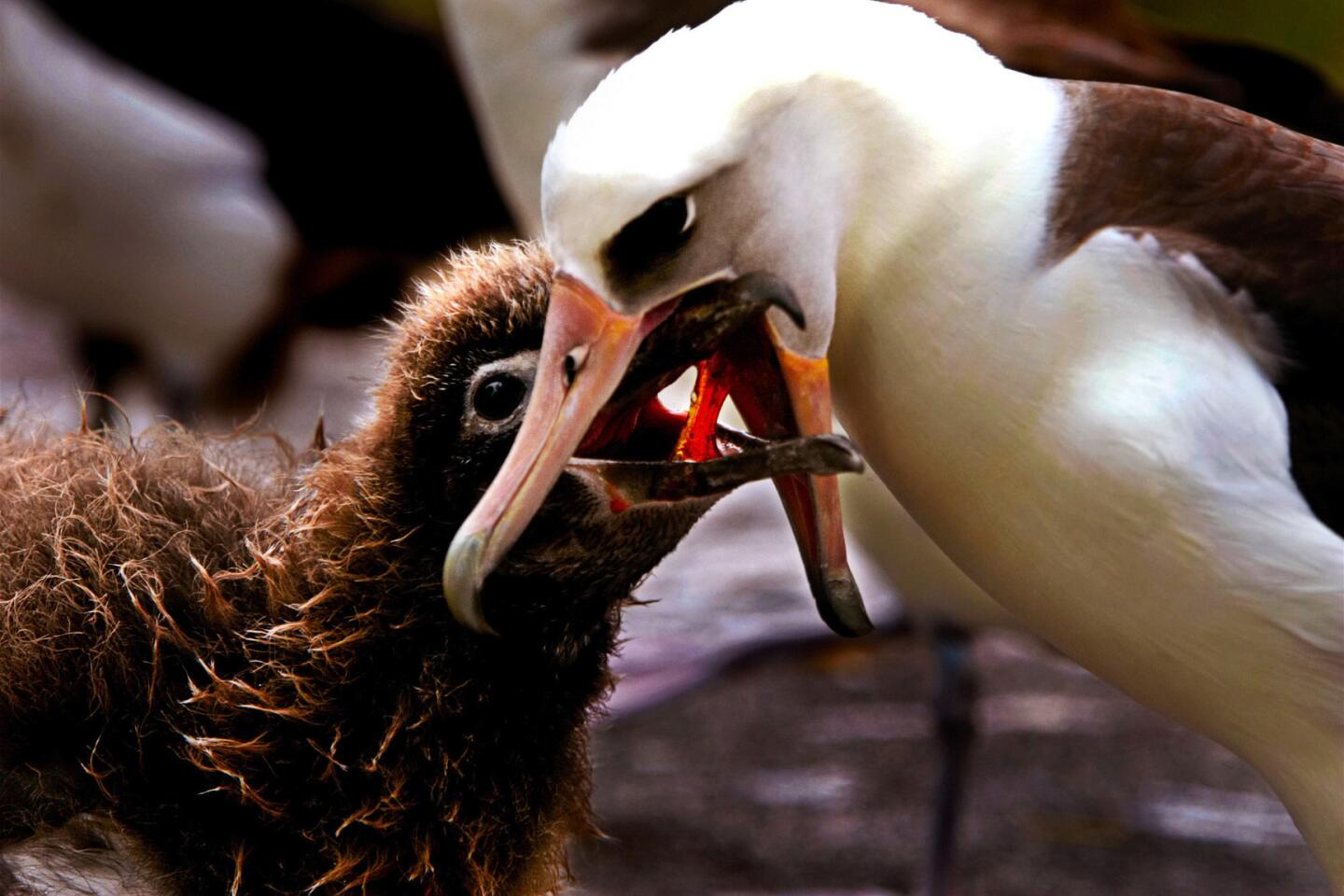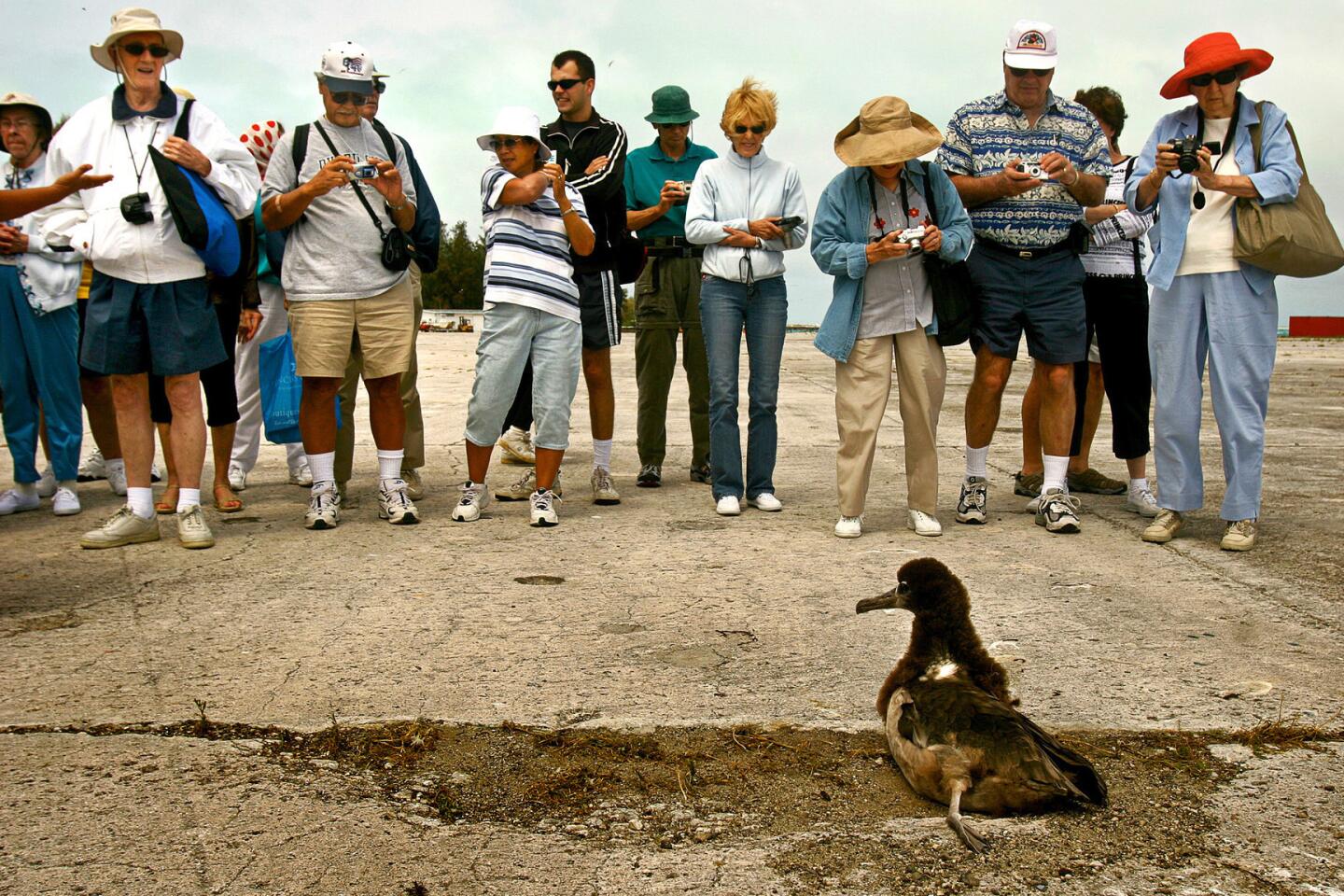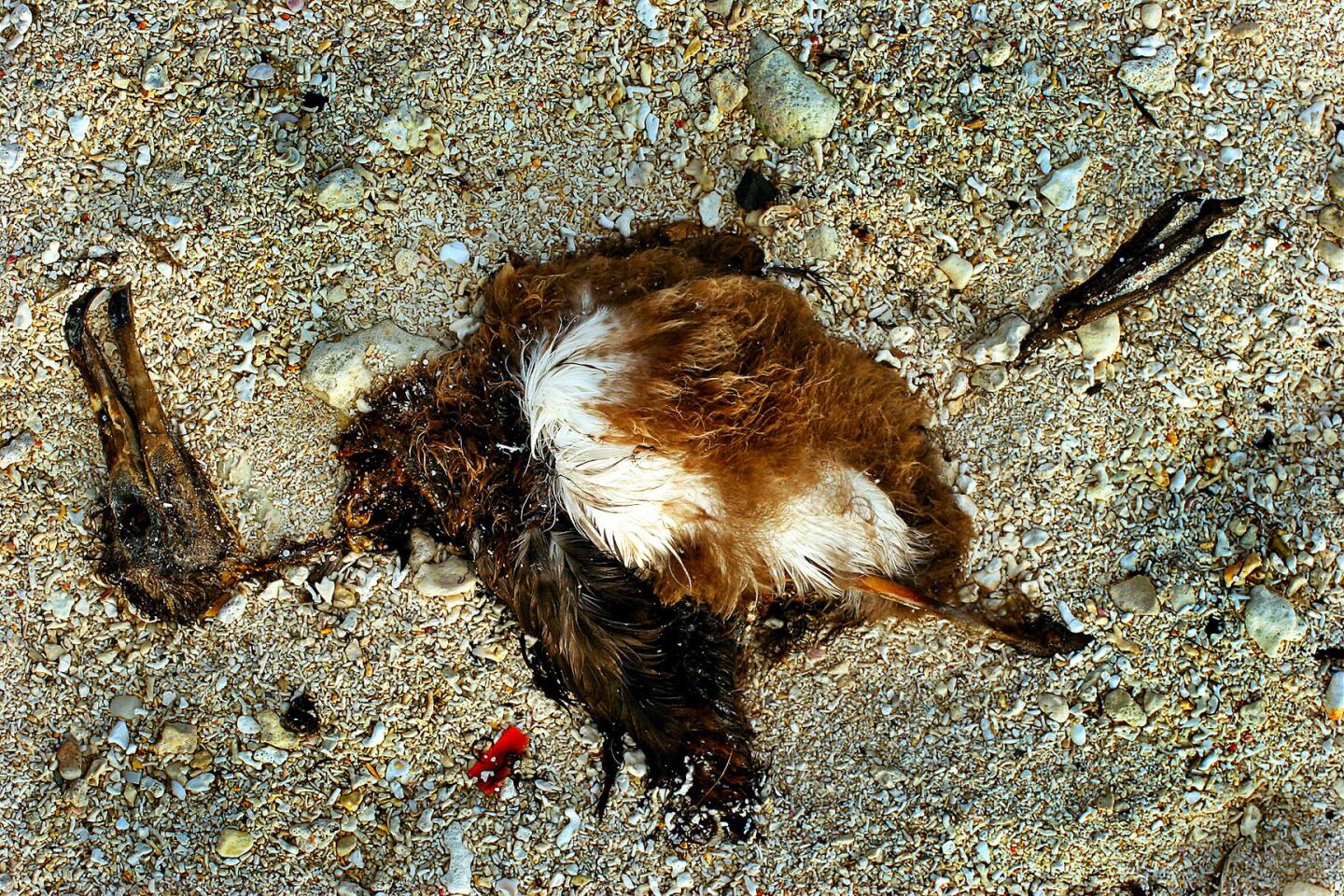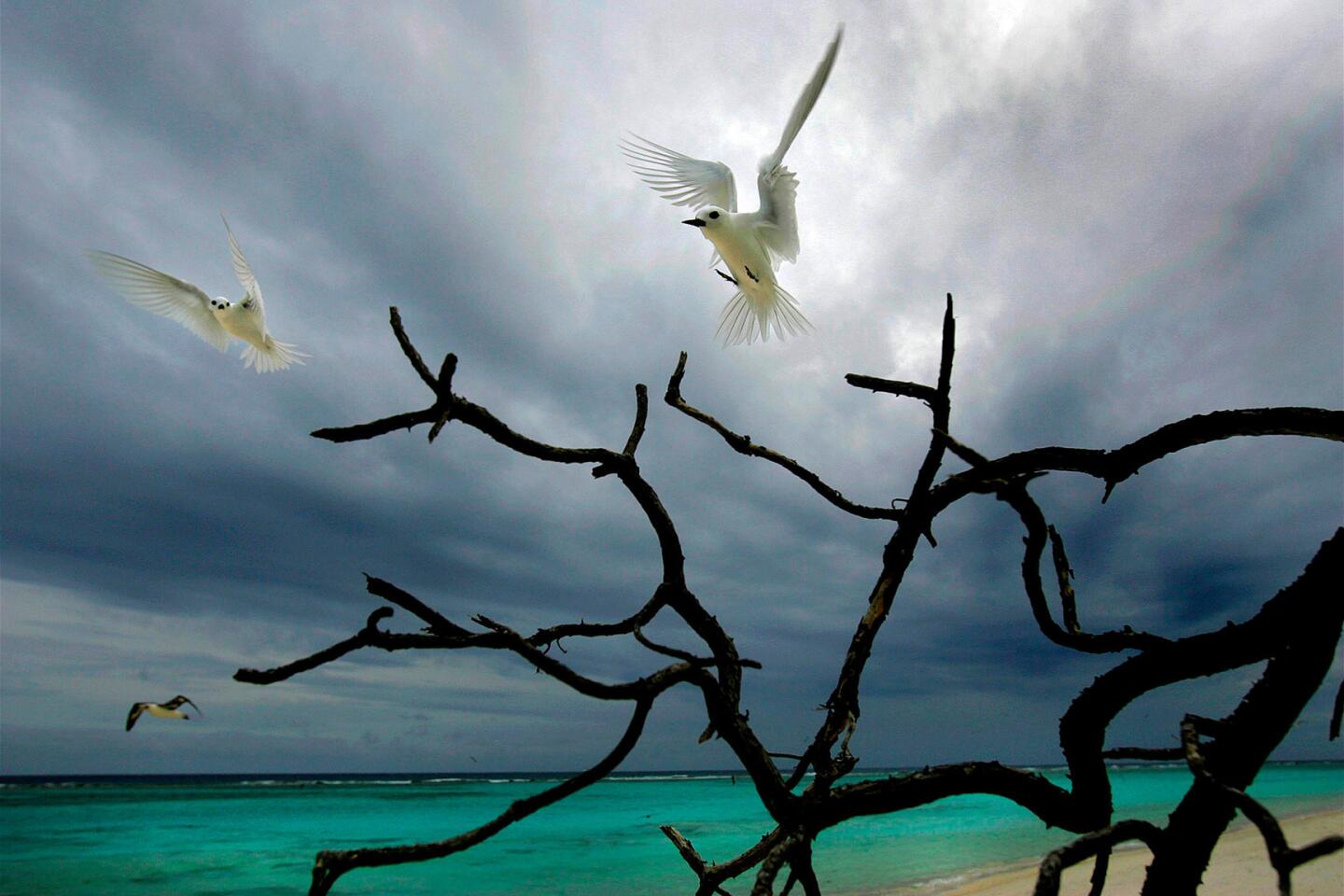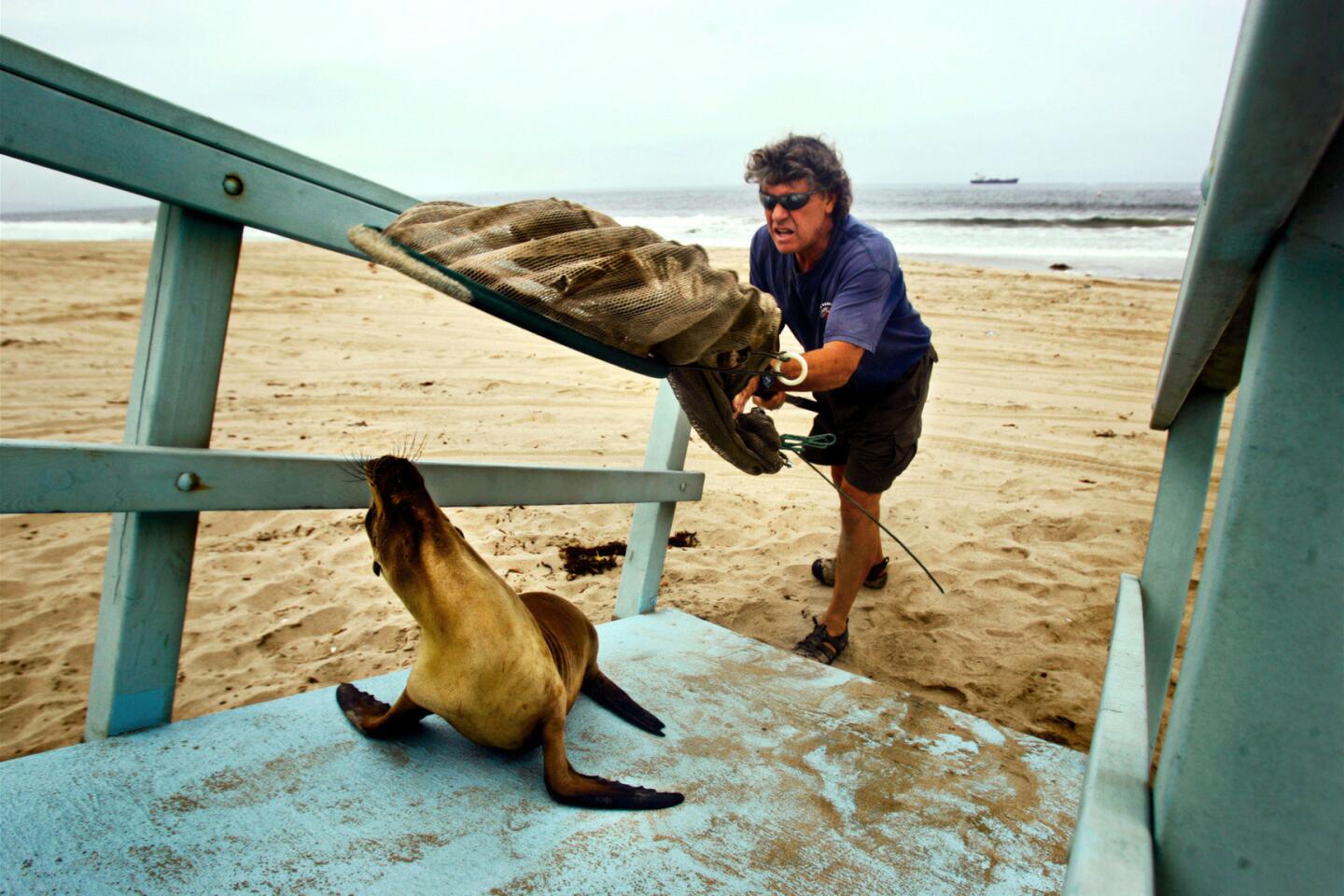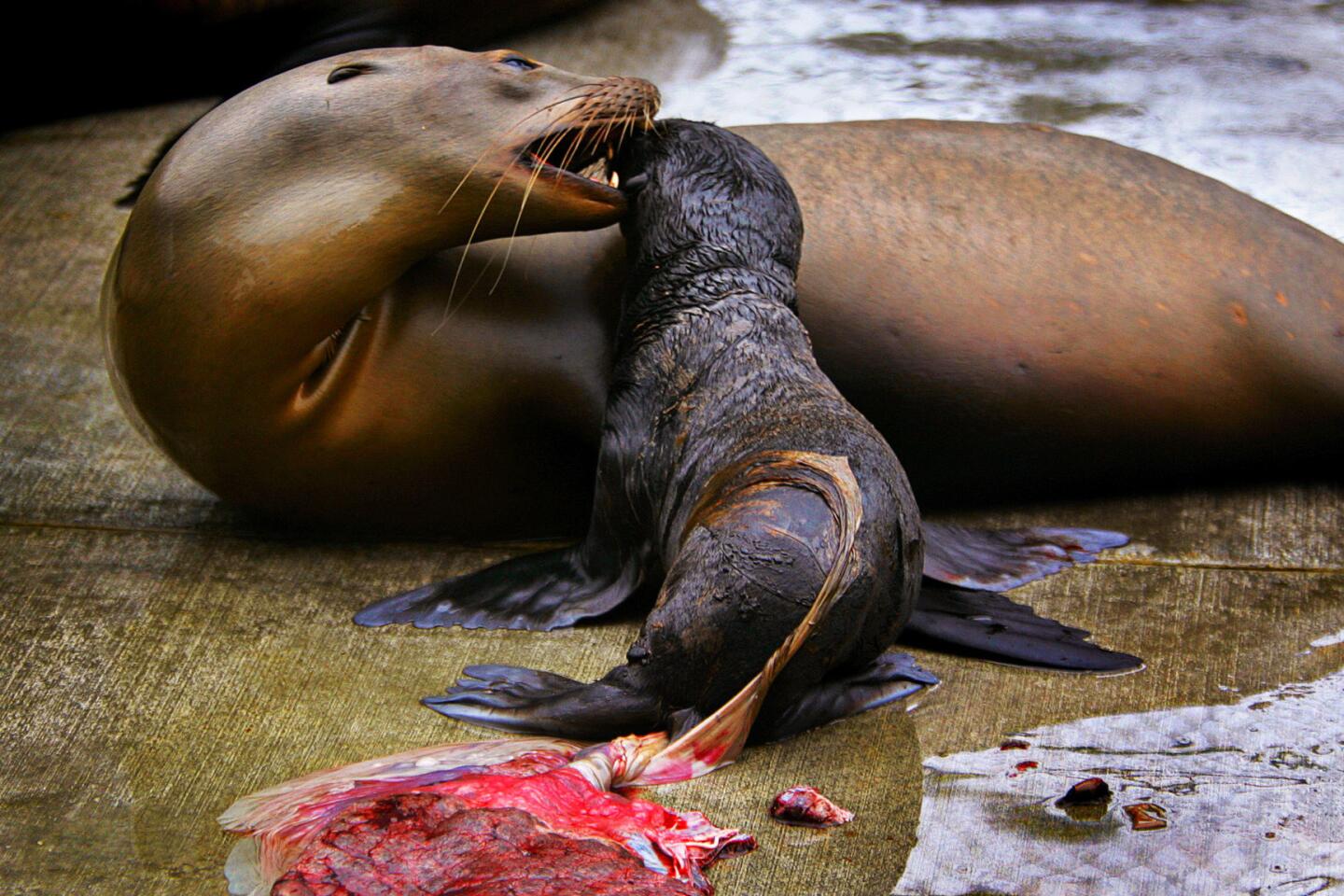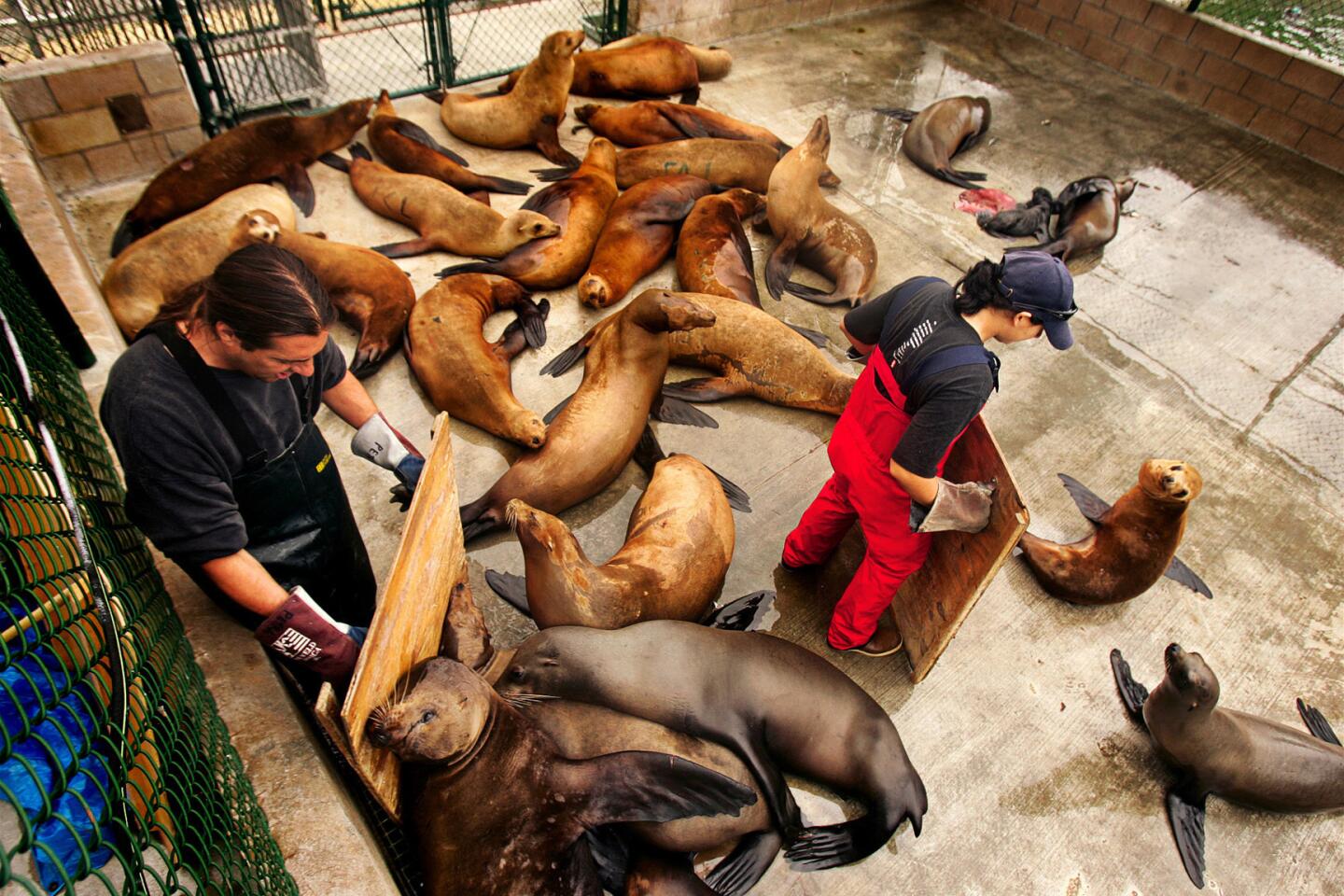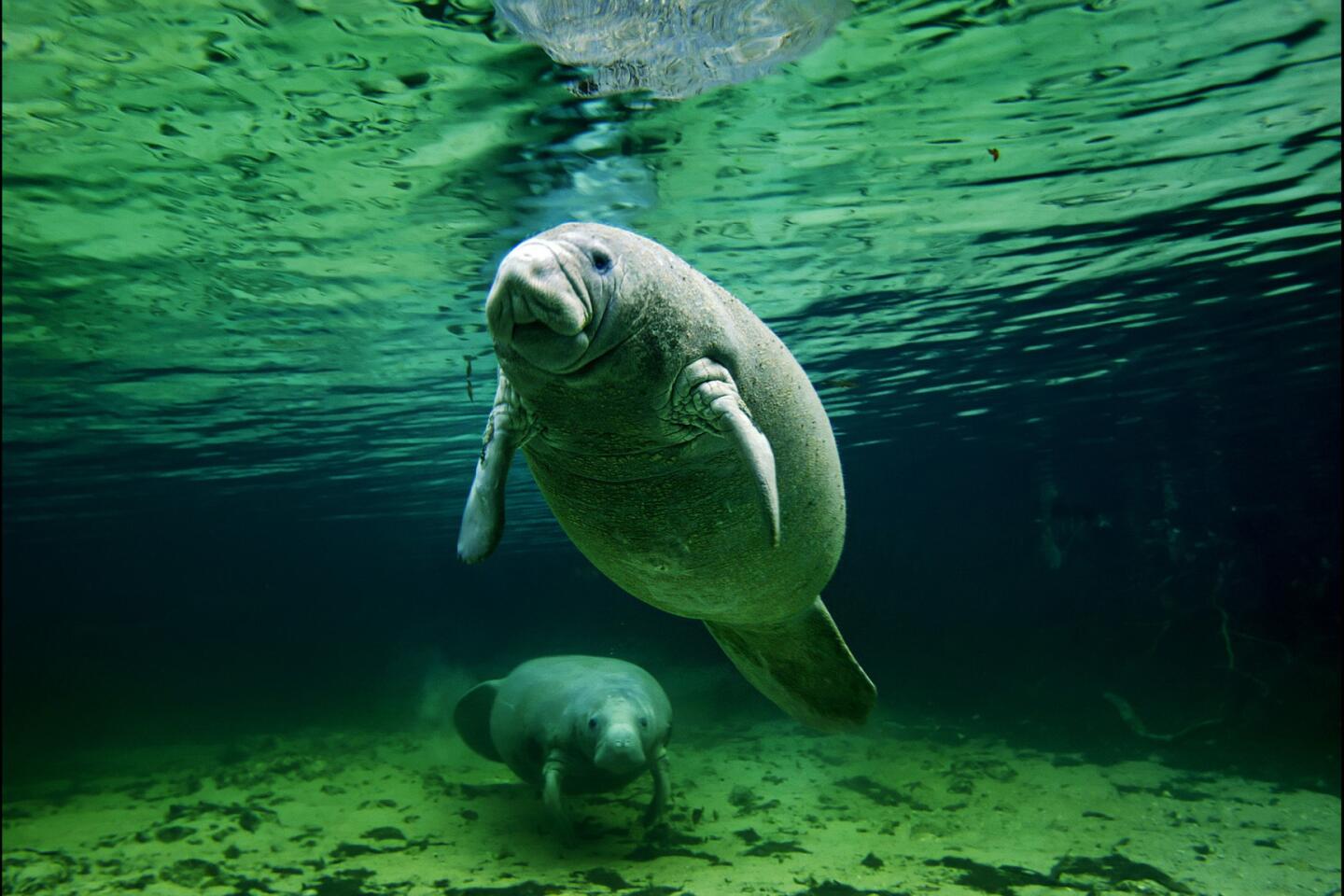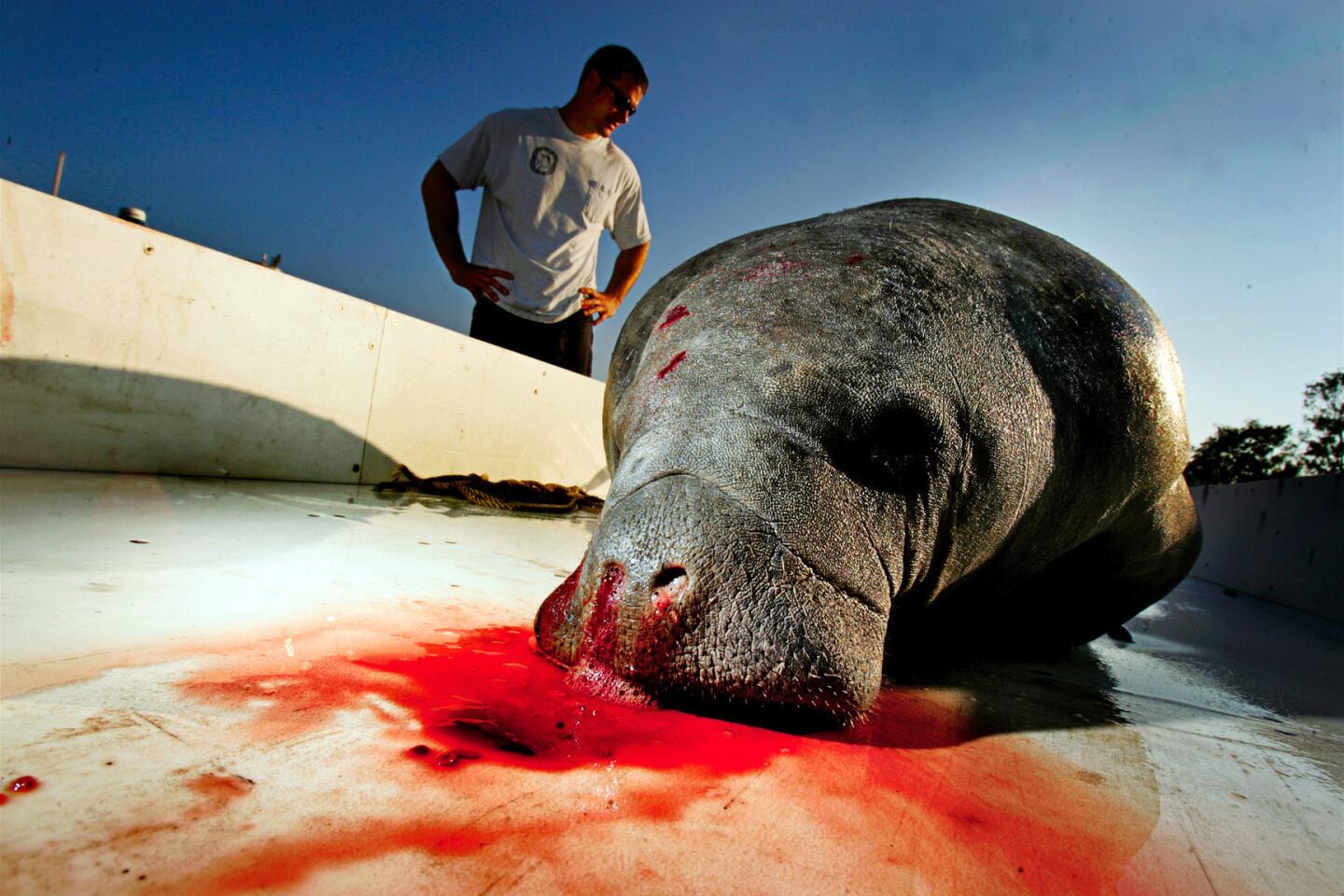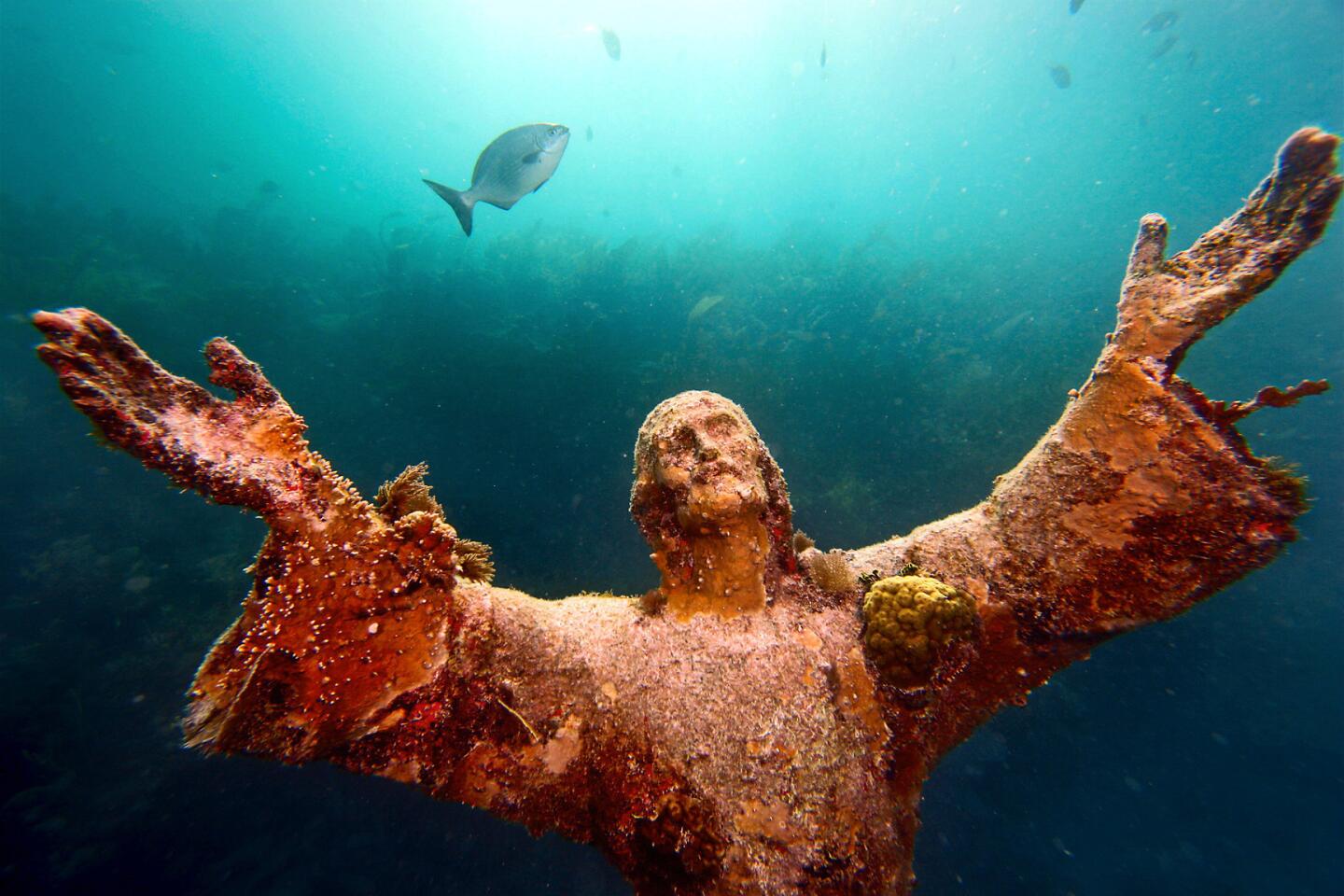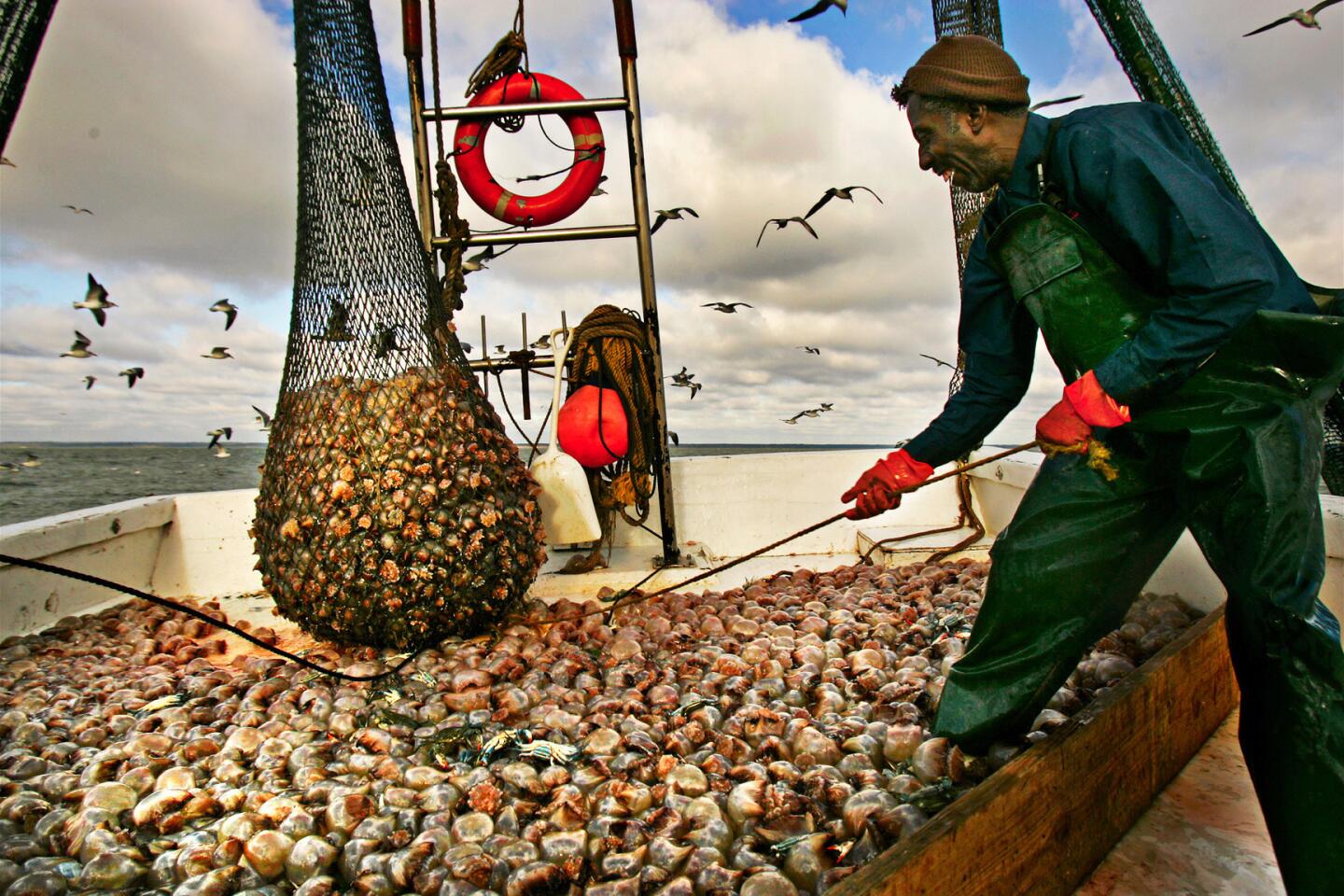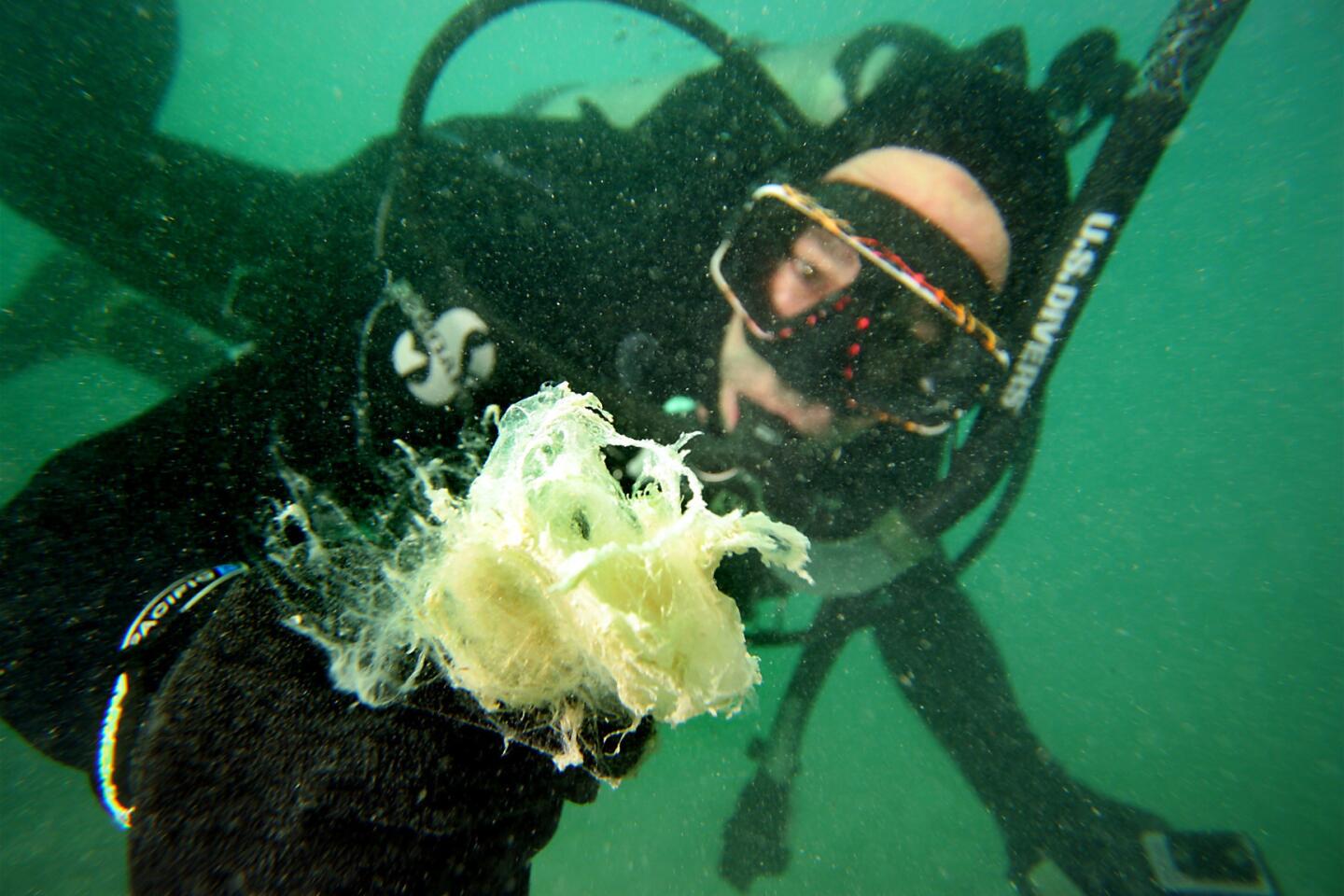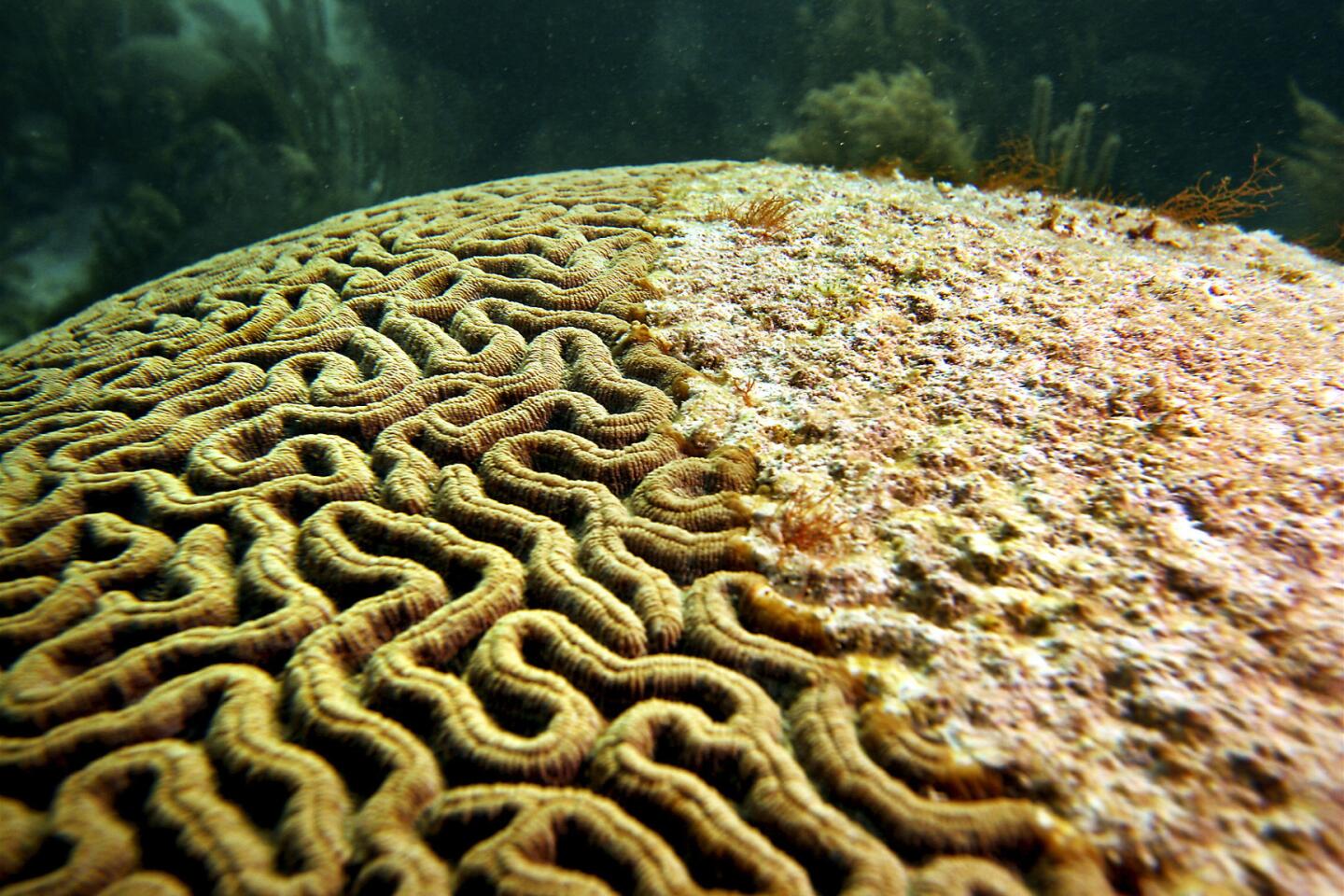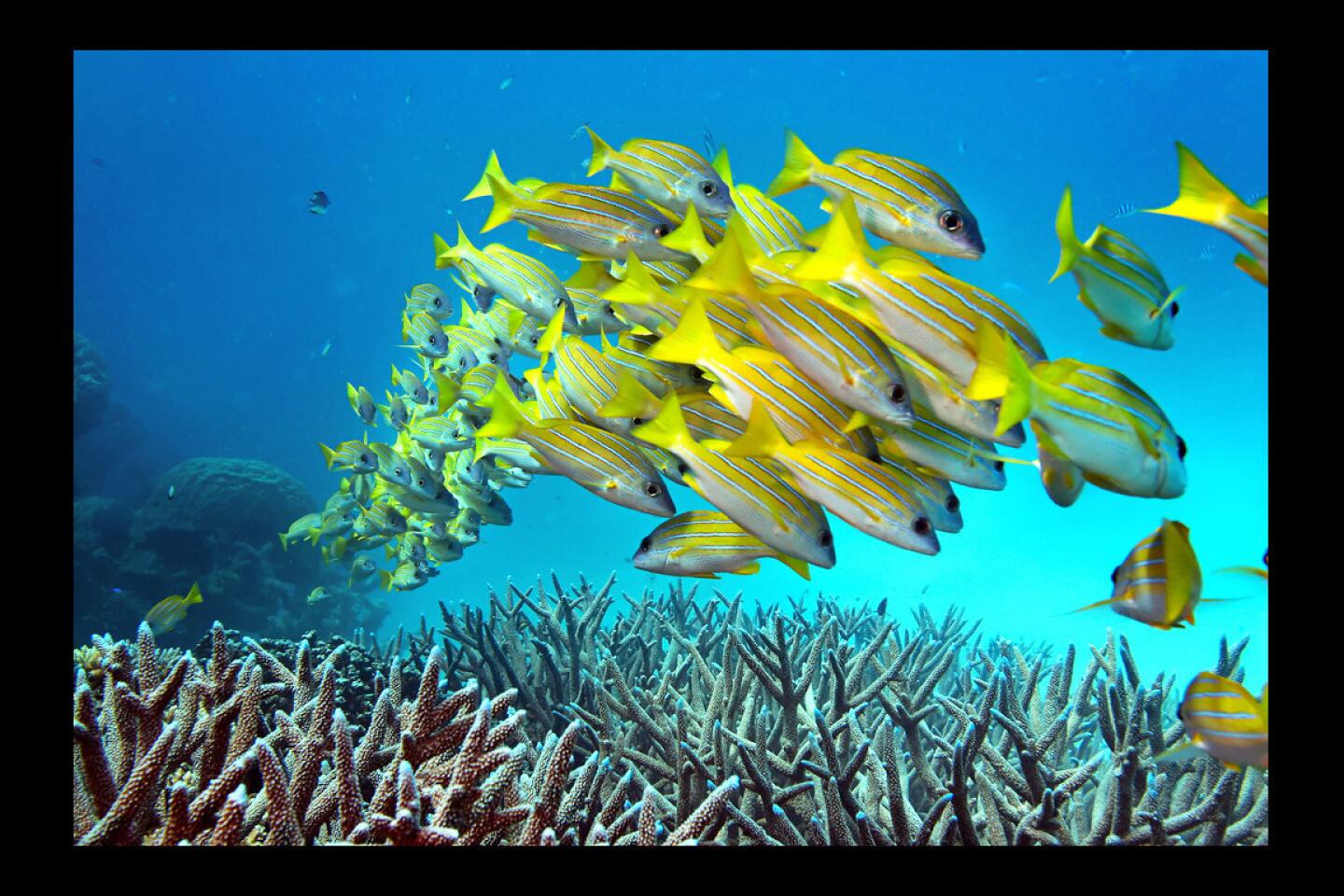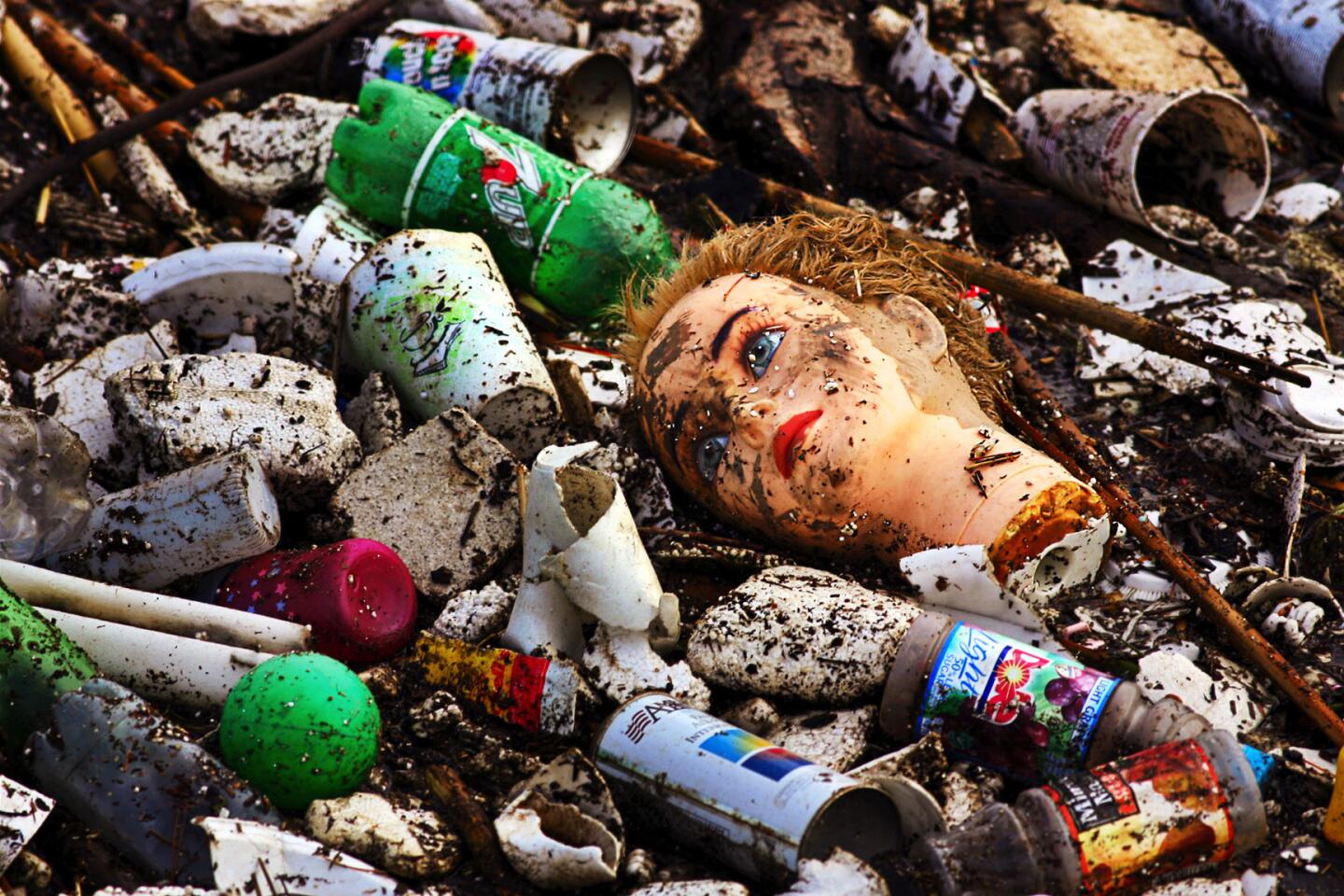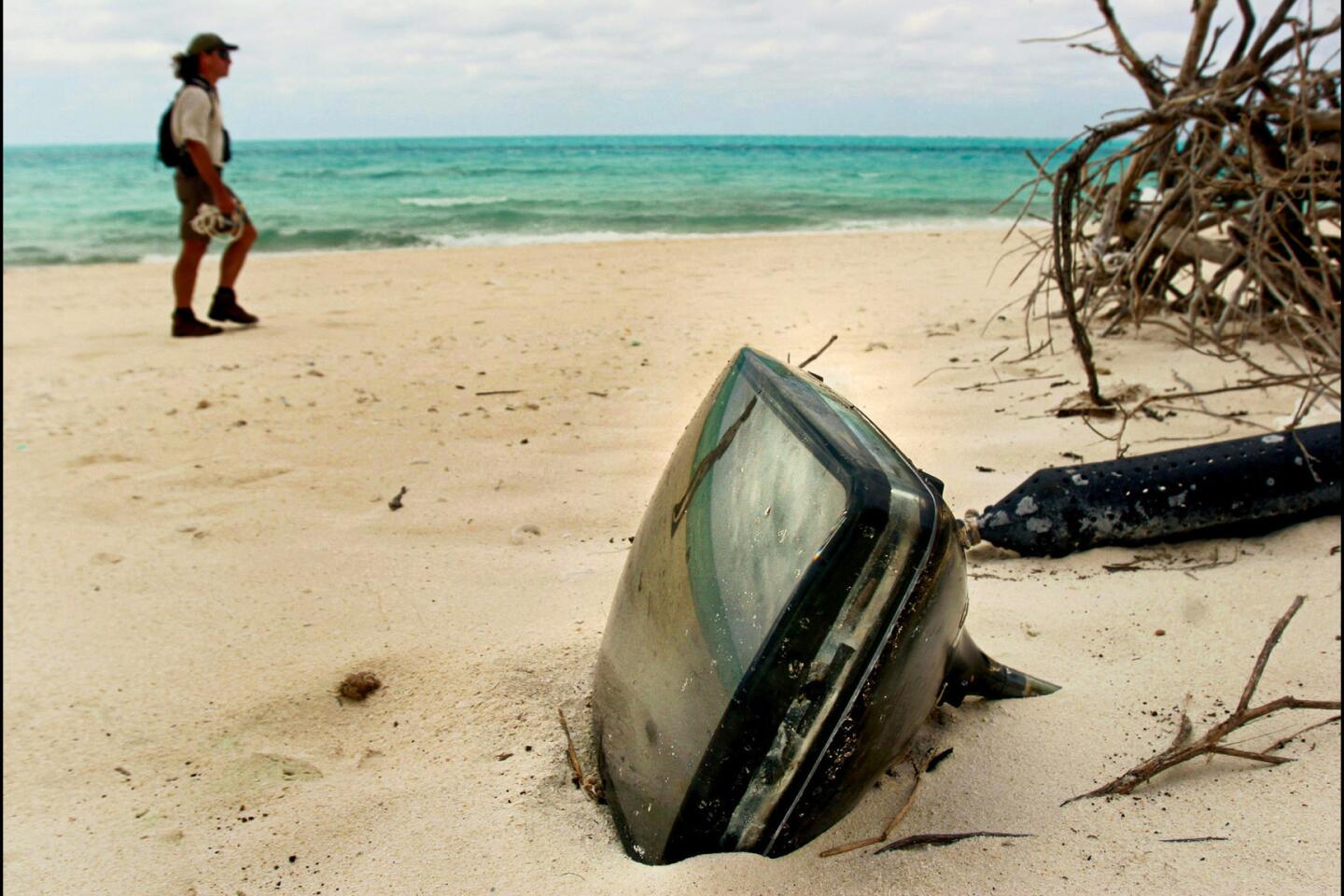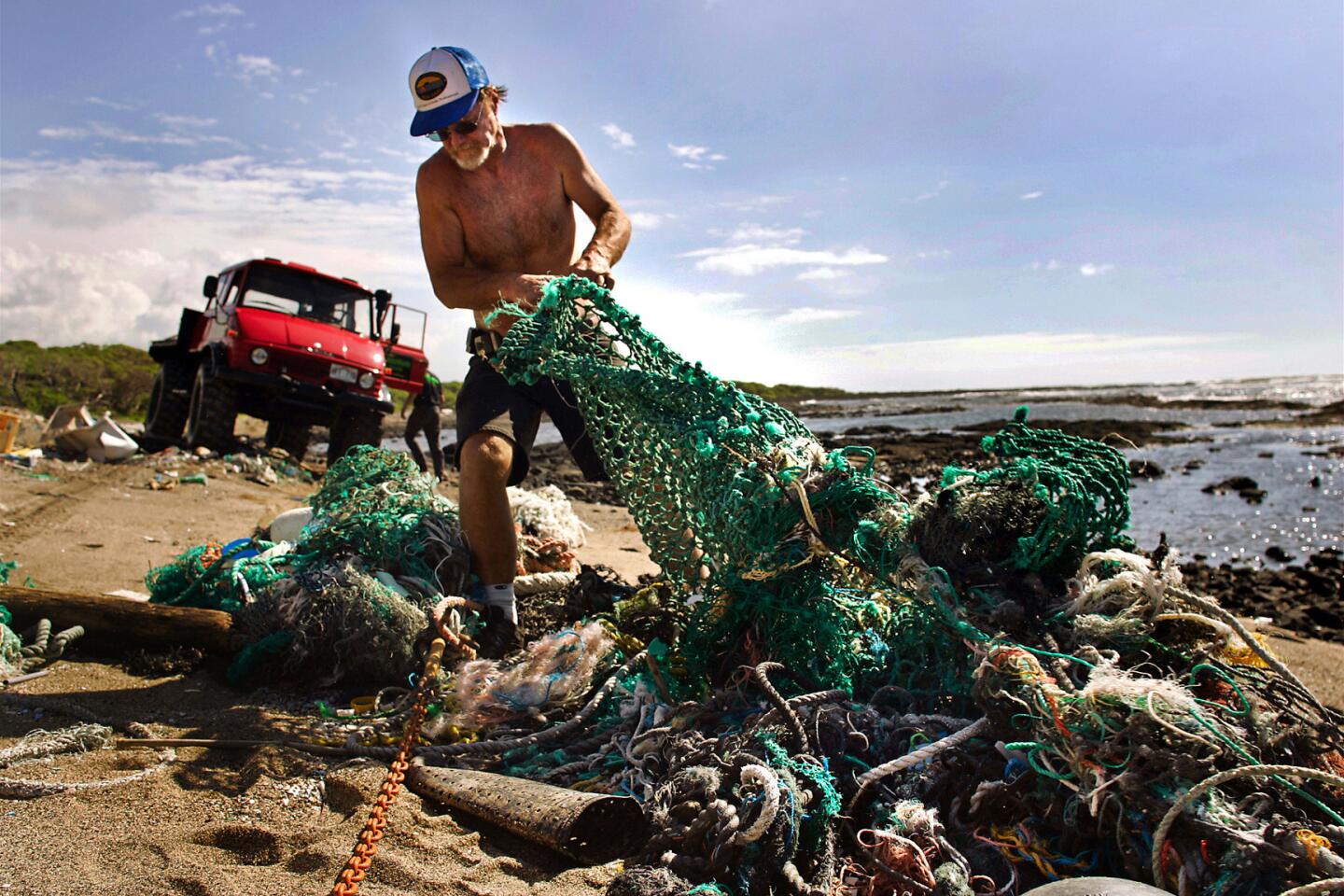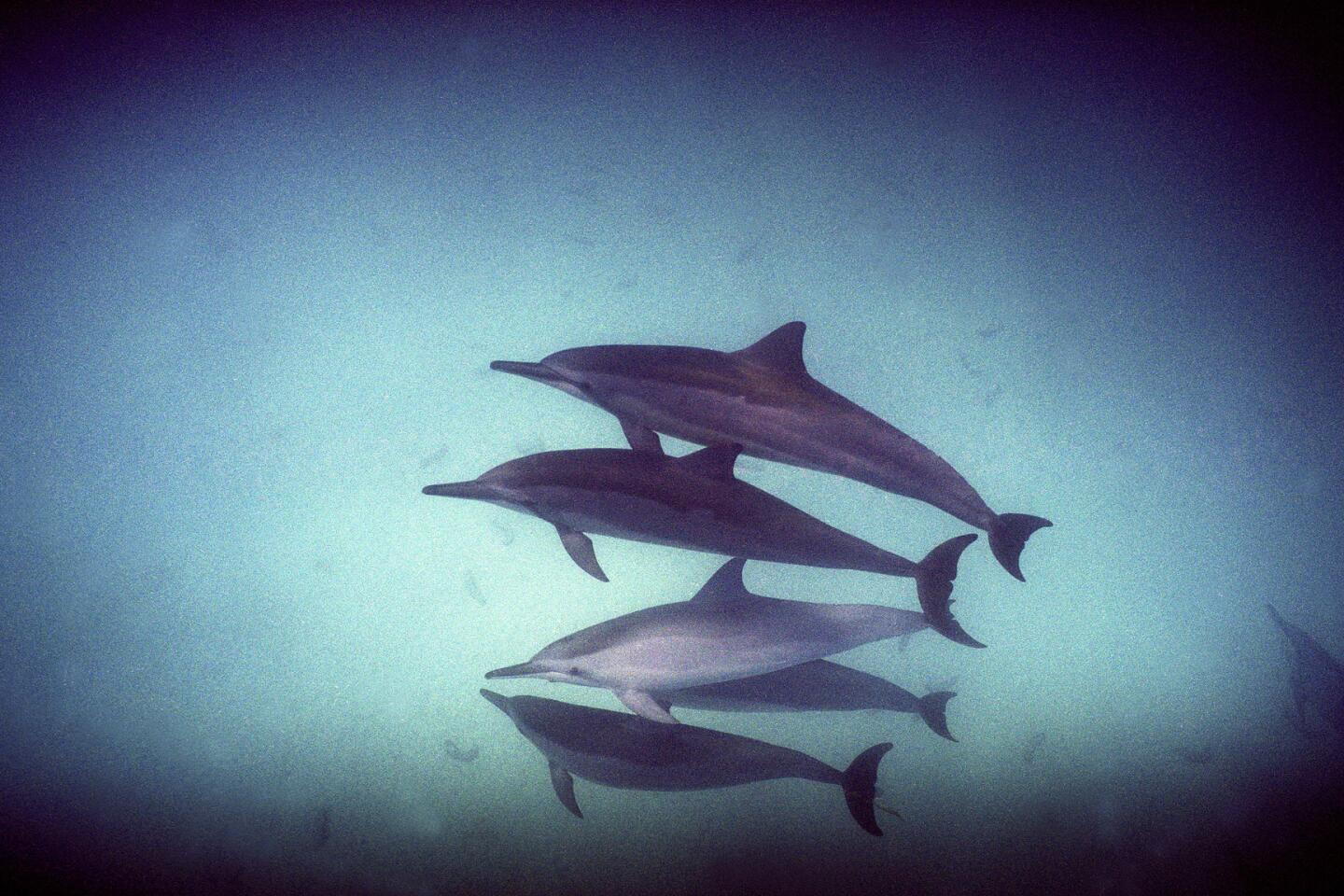Altered Oceans: Part Three: Dark Tides, Ill Winds
Reporting From LITTLE GASPARILLA ISLAND, FLA. — All Susan Leydon has to do is stick her head outside and take a deep breath of sea air. She can tell if her 10-year-old son is about to get sick. If she coughs or feels a tickle in the back of her throat, she lays down the law: No playing on the beach. No, not even in the yard. Come back inside. Now.
The Leydons thought they found paradise a decade ago when they moved from Massachusetts to this narrow barrier island, reachable only by boat, with gentle surf, no paved roads and balmy air that feels like velvet on the skin.
Now, they fear that the sea has turned on them. The dread takes hold whenever purplish-red algae stain the crystal waters of Florida’s Gulf Coast. The blooms send waves of stinking dead fish ashore and insult every nostril on the island with something worse.
The algae produce an arsenal of toxins carried ashore by the sea breeze.
“I have to pull my shirt up and over my mouth or I’ll be coughing and hacking,” said Leydon, 42, a trim, energetic mother of three who walks the beach every morning.
Her husband, Richard, a 46-year-old building contractor, said the wind off the gulf can make him feel like he’s spent too much time in an overchlorinated pool. His chest tightens and he grows short of breath. His throat feels scratchy, his eyes burn, and his head throbs.
Their symptoms are mild compared with those of their son, also named Richard. He suffers from asthma and recurring sinus infections. When the toxic breeze blows, he keeps himself — and his parents — up all night, coughing until he vomits.
If the airborne assault goes on for more than a few days, it becomes a community-wide affliction. At homeowners’ meetings, many people wear face masks.
On weekends, the Leydons escape inland. They drive three hours to Orlando so their son can play outside without getting sick. They go to a Walt Disney World resort with water slides, machine-generated currents and an imported white sand beach.
“It’s a shame to leave this beautiful place and go to a water park,” Richard Leydon said. “But we don’t have much choice. We have to get away from it.”
Harmful algae blooms have occurred for ages. Some scientists theorize that a toxic bloom inspired the biblical passage in Exodus: “ … all the water in the Nile turned into blood. And the fish in the Nile died, and the Nile stank, so that the Egyptians could not drink water from the Nile. There was blood throughout all the land of Egypt.”
What was once a freak of nature has become commonplace. These outbreaks, often called red tides, are occurring more often worldwide, showing up in new places, lasting longer and intensifying.
They are distress signals from an unhealthy ocean. Overfishing, destruction of wetlands, industrial pollution and climate change have made the seas inhospitable for fish and more advanced forms of life and freed the lowliest — algae and bacteria — to flourish.
A scientific consensus is emerging that commercial agriculture and coastal development, in particular, promote the spread of harmful algae. They generate runoff rich in nitrogen, phosphorous and other nutrients that sustain these microscopic aquatic plants. In essence, researchers say, modern society is force-feeding the oceans with the basic ingredients of Miracle-Gro.
Yet there is debate among Florida scientists over the precise causes of local outbreaks. Red tides date back at least 150 years, before the state became one of the nation’s most populous. Some scientists say their increased intensity is part of a natural cycle.
People who have spent many years on Little Gasparilla Island and in other Florida Gulf Coast communities say red tides used to show up once in a decade. Now, they occur almost every year and persist for months.
Red tide announced its arrival this summer by dumping dead tarpon and goliath grouper on the beaches. Soon after, coastal residents were coughing and sneezing.
The previous bloom, which ended in mid-February, peppered Florida’s western coast with its fiery breath for 13 months, stubbornly refusing to dissipate despite three hurricanes.
The culprit is a microorganism known as Karenia brevis.
Each Karenia cell is a poison factory pumping out toxins collectively known as brevetoxin.
During red tides, they can be absorbed into the food chain by scallops, oysters and other popular seafood and can cause neurotoxic shellfish poisoning. The effects range from gastrointestinal illness to seizures, loss of muscle control and unconsciousness.
Brevetoxin also gets into the air. It collects on the surface of bubbles and concentrates in sea foam and on dead fish.
When the bubbles burst, brevetoxin is flung into the air and carried by the wind. If inhaled, most particles lodge in the nose and throat, but some are drawn deep into the lungs. People don’t have to set foot in the ocean or even on the beach to experience a red tide. It comes to them.
Most of those affected feel as if they have a cold or an allergy. But researchers reported last year that red tides coincided with outbreaks of severe respiratory ailments.
They compared emergency admissions at Sarasota Memorial Hospital during three months of red tide with the same period a year later, when there was no toxic algae.
During the red tide, admissions for pneumonia, bronchitis, asthma, sinus infections and similar afflictions rose 54%. No such increase was reported inland.
“You can tell when it’s a bad red tide,” said Dr. Brian Garby, the hospital’s chief of emergency medicine. “The waiting room is filled with people coughing and they don’t know why.”
Most alarming was a 19% increase in cases of pneumonia, a leading cause of death among the elderly.
Brevetoxin doesn’t cause those maladies directly. Instead, researchers believe, it makes people vulnerable by inflaming their sinuses and suppressing their immune systems, allowing bacteria and viruses to flourish.
Boxy air filters stationed around Sarasota have detected the wind-borne neurotoxin three miles from the coast, said Barbara Kirkpatrick, a researcher at Mote Marine Laboratory, a private research institute in the city. “The public health message has been, ‘If you leave the beach, you’ll be OK.’ Now we know better. People who are window shopping or eating in outdoor restaurants are still being exposed to the toxins.”
Hundreds of visitors from the Midwest and New England have posted questions and complaints on websites, seeking to learn why, after a short beach vacation on the west coast of Florida, they suffered weeks of coughing, bronchial infections, dizziness, lethargy and other symptoms.
Researchers are hearing a growing number of complaints about neurological symptoms.
Ruth DeLynn, a 79-year-old retired biologist and volunteer curator at Mote Marine Laboratory, was hospitalized for five days last year with respiratory distress during a particularly virulent red tide. DeLynn also experienced numbness and a burning sensation in her legs that made it difficult to walk. She and her doctor believe the toxin triggered a resurgence of peripheral neuropathy that had been dormant for 15 years.
“If this is going to continue this way,” said DeLynn, who lives on a barrier island near Sarasota, “I’m thinking of moving inland.”
Neurological symptoms usually flare only with high levels of exposure, said Dr. Lora Fleming, a University of Miami epidemiologist and physician. “It’s all about dose.”
Fleming isn’t persuaded that people on the beach can inhale enough to suffer serious neurological effects, but she thinks surfers may be more vulnerable.
John Purdy, a former Manatee County lifeguard, was paddling his surfboard over a wave last fall when some sea foam lifted off the water and into his mouth just as he was gulping for air.
“I felt like I inhaled a garbage bag,” said Purdy, 33, a former high school swimming champion. “It locked up my lungs and throat like a paralysis.” The seconds ticked by. “I was thinking, ‘Is this the way it’s going to end?’ ”
Eventually, he managed to sneak in a little air. It was like sucking through a cocktail straw. He made his way to shore but didn’t feel much better until emergency medical technicians hooked him up to oxygen. “It was the closest thing I’ve had to a near-death experience,” he said.
Unlike surfers, marine mammals can’t seek refuge on land. Last year’s red tide took the lives of at least 88 manatees, some weighing more than a ton. Hundreds of these massive sea cows have succumbed during outbreaks in previous years.
Greg Bossart, a veterinarian and pathologist at Harbor Branch Oceanographic Institute in Fort Pierce, dissected the tissue of manatees and determined that many died from inhaling brevetoxin-laden air just above the ocean’s surface. The result was a cascade of nerve and tissue damage that filled their lungs with blood.
“The manatees are gassed to death,” Bossart said. “They die of toxic shock.”
Bossart considers the manatee a sentinel for human health, or, as he puts it: “Florida’s 2,000-pound canary. We’ve opened a Pandora’s box of health issues.”
The oceans are awash in microscopic algae, or plankton. But of the thousands of different kinds, only about 100 produce toxins.
About 60,000 people in the United States are poisoned each year by algae blooms. Most get sick by eating fish and shellfish that concentrate neurotoxins from the vast quantities of algae they consume.
The Centers for Disease Control and Prevention estimates that only 2% to 10% of all cases are reported to health authorities — usually those that involve numbness, paralysis, coma or other severe symptoms. Cases of nausea, cramping and diarrhea tend to go unreported.
Estimates of algae-related illness don’t include the many thousands of people in Florida and other Gulf Coast states who suffer from inhaling airborne brevetoxin.
Nearly every coastal region has outbreaks of harmful algae or bacteria.
For the second summer in a row, shellfish beds in New England are being closed because of toxic algae that cause paralytic shellfish poisoning. These blooms that typically begin in the Gulf of Maine were rare until the 1970s. Now, they appear almost every year, often spreading down the coast as far as Cape Cod.
California and other West Coast states periodically have banned shellfish harvesting because of toxic algae, including Pseudo-nitzschia, which wasn’t identified until 1987. That was when it killed three people who ate contaminated mussels in Montreal. Since then, it has left California’s coastline littered with dead and dying marine mammals and seabirds.
Marine biotoxins are among the most potent biological poisons ever discovered. Saxitoxin, which causes paralytic shellfish poisoning, is listed among chemical agents banned under a United Nations compact on weapons of mass destruction. As with other algae-produced neurotoxins, there is no known antidote.
People help spread harmful algae by fertilizing them with sewage and farm runoff, transporting them in the ballast water of ships, dredging harbors or warming seawater through climate change.
Patricia M. Glibert, a marine scientist at the University of Maryland, has found that the worldwide spread of paralytic shellfish poisoning has closely tracked the expanding use of urea, a nitrogen fertilizer.
Glibert estimated that fertilizer use will rise 50% this decade “in parts of the world that are already saturated with nitrogen and frequently plagued by harmful blooms.”
Donald Anderson and colleagues at Woods Hole Oceanographic Institution in Massachusetts traced the origin of a strain of algae responsible for a 1998 outbreak of paralytic shellfish poisoning on France’s Mediterranean coast. Analyzing DNA and shipping records, they concluded that it hitched a ride from Japan in the belly of a ship.
Disturbance of the seafloor by dredging is believed to help promote the growth of algae that cause ciguatera fish poisoning. About a million people a year show signs of ciguatera poisoning — such as gastrointestinal distress, numbness, weakness, vertigo and coma — after eating fish from tropical waters.
Cruise ship passengers who ate raw oysters from Alaskan shellfish beds became violently ill two years ago in an outbreak that medical researchers tied to the bacterial pathogen Vibrio, common in the Gulf of Mexico. Researchers realized the strain had moved 600 miles farther north than ever before, as Alaskan waters warmed above the 59-degree threshold that limited the bacterium’s range.
A University of Miami marine biologist, Larry E. Brand, examined water samples dating to 1954 and found that outbreaks of Karenia brevis off Florida’s Gulf Coast are getting stronger, lasting longer and spreading farther.
“When you look at it statistically, red tides are 10 times more abundant than they were 50 years ago,” Brand said. Once, “the peak time was in the fall…. Now we have blooms continuing on and lasting into the winter and spring.”
The highest concentrations of algae, he said, were along heavily developed shorelines and around the mouths of rivers that disgorge nutrient-laden waters from sugar-cane fields and sediment from phosphate mines.
Brand said that was no coincidence. It reflects “a huge increase in sewage, runoff from lawns and golf courses, mining and agriculture,” he said.
State officials say Brand may be misinterpreting the water samples. Cynthia Heil, a senior state scientist, said the data do not support the conclusion that pollution from agriculture or development spawns red tides, although she said it may intensify or prolong the outbreaks.
Heil said there is compelling evidence of blooms that originate out at sea, far from coastal concentrations of man-made pollutants.
She and a team of university scientists in Florida have published a study theorizing that iron-rich dust from Africa’s Sahara Desert drifts across the Atlantic and triggers a natural process that stimulates harmful algae blooms off Florida’s Gulf Coast.
“The timing sure matches up with blooms,” Heil said. “We know it has to contribute to enriching seawater with iron and nitrogen.”
A television suspended from the ceiling at Mote Marine Laboratory in Sarasota plays a public service announcement sponsored by state and federal agencies, offering hints for dealing with red tide.
“If you are going to the beach for a short trip, go to your local drugstore and buy a face mask, like the ones painters wear,” the narrator says. “But remember, these masks are only effective for a short time.
“People with asthma should also be sure to take their inhalers to the beach and use them as prescribed. If your inhaler is not providing relief, seek immediate medical attention.”
Tourist officials point out that red tides come and go and vary in intensity, and that the airborne toxins don’t trigger health problems unless there is an onshore breeze. Beachgoers on one stretch of coast can get a heavy dose, while others a few miles away aren’t affected.
Last fall’s red tide was one of the worst on record.
Tourists bailed out of hotels and motels, said Dianne Manspeaker, manager of the Gulf Surf Resort Motel in Nokomis. “People come to check in and say, ‘I can’t stay here, I can’t breathe.’ ”
Manspeaker is sympathetic to tourists who feel ill and refunds their money. She lives inland, and when the wind blows brevetoxin onshore, she stays home and tends to business by phone. “If I have to be here,” she said, “I wear a mask.”
A few miles up the coast, Sarasota County lifeguard Mike Zanane listened to a familiar chorus of coughs, throat-clearing, sneezes and nose-blowing from hundreds of beachgoers.
It was a typical day at the beach during red tide, Zanane said. The die-hards lie in the sun and cough all day. They won’t leave. Nor will they venture into the surf, and Zanane doesn’t blame them.
“Sometimes,” he said, “you go out there and you feel like you’ve been Maced.”
Red tides have become a staple of the daily reports on surf conditions posted on the lifeguard tower. The sign read: “Some Red Tide = Coughs. Sneezes. Dead Fishes.” A few extra words were scribbled in chalk in the margin: “Can’t do anything about [it].”
Not that people haven’t tried.
In one experiment, researchers from Mote Marine Laboratory sprayed a slurry of clay onto the murky water in an effort to smother and sink the offending organisms. Another experiment in the works would sterilize algae patches with injections of ozone. Such remedies can be problematic. Not only do they kill the harmful algae, they wipe out every living thing in the vicinity.
Jim Patterson, a past mayor of Longboat Key next to Sarasota, would have been satisfied just to rid the beach of the stench of dead fish.
A retired Army general, Patterson took the fight to the fish. He hired a boat and crew and set out to chop up the carcasses with a fish shredder before they could reach the shore.
The results were disappointing for Patterson and his nonprofit group, Solutions To Avoid Red Tide. Instead of whole fish, Longboat Key was littered with decaying fish chunks.
Buddy Gaines invited a visitor to look out at the Gulf of Mexico from his oceanfront house built on stilts on Little Gasparilla Island. “You can see why we love it here,” the retired filmmaker said. “It’s a shame we cannot go outside.”
Gaines and his wife, Laurie, don’t let their dogs — a pair of Hungarian vizslas — outside either. Not during the bloom of a red tide. It’s a costly lesson the couple learned a couple of years ago.
Their younger dog, Olivia, was a gregarious puppy who loved to frolic in the sand, splash in the warm surf and follow joggers down the beach.
One morning, after eating a few small fish that had washed up, she arrived home staggering and stumbling. By the time the Gaineses got her to a vet, Olivia couldn’t see. She was vomiting and convulsing.
“It was heartbreaking to watch,” Laurie Gaines said. “We didn’t think she was going to live.”
Veterinarian Amanda Schell didn’t know what to make of the symptoms.
“Did she eat rat poison?” the vet asked. “Did she get into antifreeze?”
Schell ran blood tests, looking for West Nile virus and canine distemper. Finding no clear answers, she sent the couple to a specialist in Tampa.
The next day, local veterinarians treated 16 dogs — all twitching, vomiting and suffering from seizures. One died.
Buddy and Laurie Gaines embarked on a monthlong odyssey to save Olivia that took them to clinics, animal hospitals and finally Tufts University’s veterinary school in North Grafton, Mass. The couple camped in the parking lot in their motor home while Olivia was cared for inside.
“Sometimes I think I’m the biggest fool in the family to have spent $22,000 on this dog,” said Buddy Gaines, 70, sitting on his couch with Olivia. “I had to take out a second mortgage. But I don’t care. I love this dog.”
Olivia, now 3 years old, appears fully recovered, except for her incessant drooling. Veterinarians suspect it’s a sign of residual neurological damage.
A half-mile down the beach, Susan and Richard Leydon were keeping their dog, a sheltie, inside, along with their son, Richard. The air conditioner was going full blast.
Richard’s bedroom is at the seaward side of the house with a picture window overlooking the gulf. “I have the best room,” he announced.
It’s the best room until the wind begins to blow hard off the ocean. Then it’s the first to get dosed with toxin-laden air, coming through the cracks and electrical outlets. It leaves a vague metallic taste on the back of the tongue.
The family has taken to wearing surgical masks on windy red tide nights. It’s not enough to keep Richard from coughing. His parents also move him into a room on the other side of the house.
Richard has spent nearly his entire life on the island and was among the first residents to develop symptoms. His most common ailment is a dry cough, which he says makes him sound like a barking seal.
The airborne irritants have also triggered recurring sinus infections and asthma. On a few occasions, during intense and prolonged red tides, Richard has been diagnosed with bronchitis and even pneumonia, which kept him out of school for more than a month.
The Leydons said they have consulted with specialists and spent thousands of dollars on tests trying to figure out if something other than red tide was making their son sick. Doctors couldn’t pinpoint anything.
The couple worry about the price their son is paying for their decision to move to Florida.
“Is Richard is going to have lung scarring and long-term problems?” his father asked. “I need to know.”
The conversation in the Leydon household focused on two topics, as it often does during red tide outbreaks. One was where to flee for the weekend. The other was whether they should move, for good.
“Do we have to sell our house because paradise is killing us?” Susan Leydon asked.
Times staff writer Usha Lee McFarling contributed to this report.
Next: Altered Oceans, Part Four: Plague of Plastic Chokes the Seas
Full coverage: Altered Oceans
More to Read
Sign up for Essential California
The most important California stories and recommendations in your inbox every morning.
You may occasionally receive promotional content from the Los Angeles Times.
